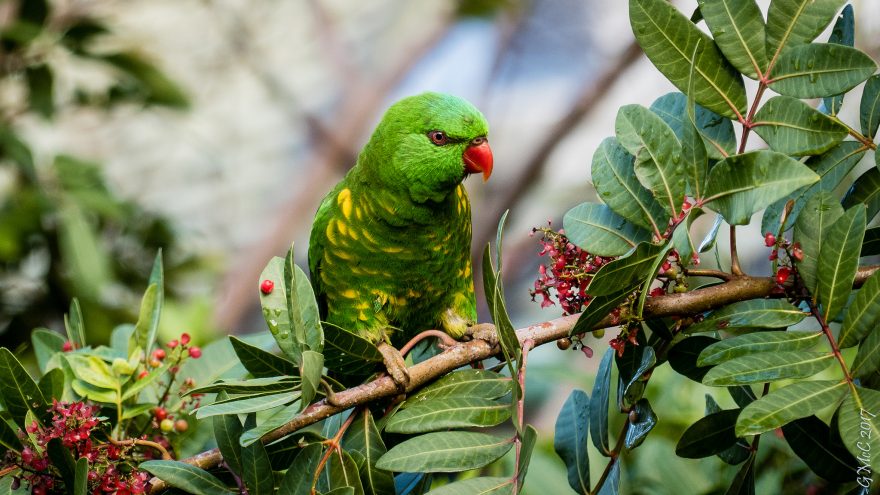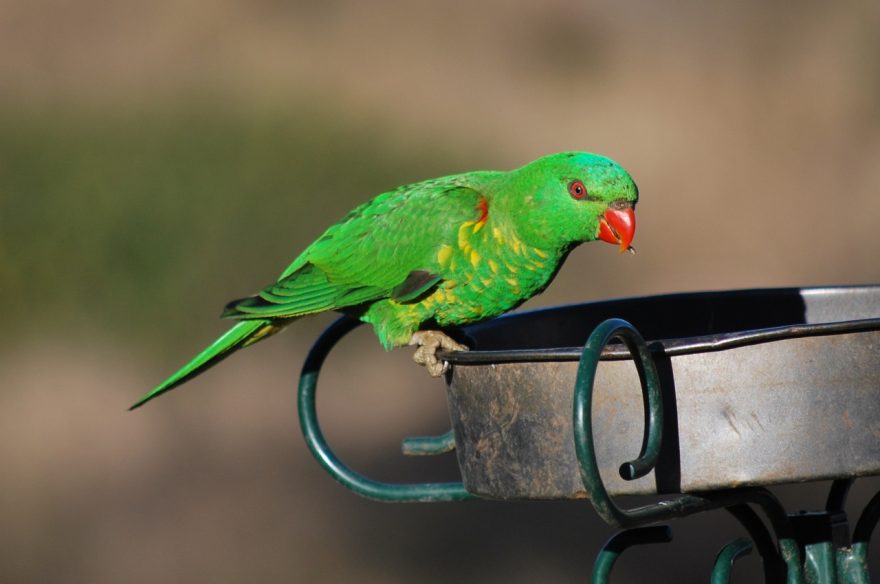Scaly-breasted lorikeets are a medium-sized parrot found in the woodlands of eastern Australia. They are less common than the closely-related rainbow lorikeet, but are otherwise quite similar in diet, care requirements and temperament. Scaly-breasted lorikeets are popular as pets, and have a reputation for being intelligent and easy to train.

Housing & Compatibility
Due to their high-moisture diet, Lorikeets produce a large amount of liquid faeces. A cage or aviary that prevents birds from being able to touch their droppings is essential. This reduces exposure to dangerous bacteria and parasites. Frequent cleaning is necessary and the aviary should be designed to accommodate this. A substrate of sand or gravel that can easily be replaced or pressure-cleaned is needed in traditional style aviaries. Many breeders use suspended flights, which allow droppings to fall through the bottom.
Lorikeets are poor at vertical flight, so an aviary at least 3m in length is recommended. Perches should be placed as far apart as possible to encourage distance flight.
Scaly-breasted lorikeets can be somewhat aggressive and should only be housed in single-pair aviaries.
Diet & Feeding
Lorikeets possess a brush tipped tongue which is used to extract nectar and pollen from flowering trees. In captivity; a commercial lorikeet mix and a variety of fruit and vegetables is acceptable. Apple, pear, grapes, tomato and strawberries are particularly enjoyed.
Commercial lorikeet mixes can often be fed dry (in powder form) or wet (mixed with water). Dry food and fresh water should be available at all times, as wet lorikeet food spoils quickly and needs to be replaced several times a day – especially in hot weather.
Lorikeets should not be permitted to consume seed, as it can damage the brush tip on their tongue and contribute to a variety of health issues; many of which lead to a reduced lifespan.

Breeding
Musk lorikeets will breed from autumn through to late spring, however year-round breeding can occur in moderate climates. They typically produce one or two clutches of two chicks per season, but larger or more frequent clutches do occasionally occur.
They will readily accept a wide variety of nest boxes in many different shapes and sizes. Hollow logs can also be used, ideally hung from the ceiling to limit access from vermin. The nest box should have a shallow bed of rotting wood, sawdust or pine shavings to provide cushioning. The large amount of liquid faeces produced by young birds will quickly soil the nest box, so it needs to be thoroughly cleaned between clutches. Some breeders drill small holes into the bottom of the next box to allow moisture to escape.
Scaly-breasted lorikeets will begin breeding at approximately one year of age. They will not breed unless there is a strong pair bond, signified by mutual preening and feeding. The male will begin the breeding process through a courtship display of bobbing and hopping. If copulation is successful, the female will lay two white eggs that she incubates for 24 days.
The chicks will fledge the nest at around 8-9 weeks of age. They become independent from their parents quite after two or three weeks. Watered-down wet lorikeet food can be provided to help young chicks learn to feed independently. Young birds can be kept with their parents indefinitely, however some aggression can occur in subsequent breeding seasons.
Sexing
Both sexes look virtually identical, so surgical or DNA sexing may be required. Experienced keepers may be able to ascertain a bird’s gender based on behavioral characteristic.
Mutations
Several colour mutations have been established, including yellow and olive. A rare blue mutation is also occasionally seen.
Most scaly-breasted lorikeets with an unusual appearance are the result of interbreeding between different lorikeet species rather than true mutations.
Health
Due to their high-moisture diet, lorikeets produce a large amount of liquid faeces. If aviary hygiene is not adequately maintained, bacterial and fungal infections can thrive. In traditional aviaries, keeping the substrate as dry as possible is essential. Ensure there is good drainage and a substrate—ideally sand—that can be frequently replaced.
Similarly, it’s important that a lorikeet’s food supply is not permitted to spoil. Fruits, vegetables, and “wet” lorikeet food should be removed on the same day as it’s placed in the aviary. In hot weather, food will spoil more quickly so it may be necessary to provide multiple feedings throughout the day.
A preventative worming and parasite control regime should be applied to ensure the long-term health of your birds.
A healthy Scaly-breasted lorikeet should have an expected lifespan of 15-20 years.
After mating how long does it take to lay there eggs?
Why do they stamp their little feet like a dance in their hutch